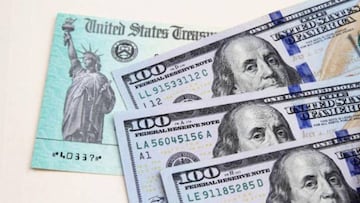How to claim a stimulus check from the IRS on a 2020 tax return
Despite sending out millions of stimulus checks to Americans, the IRS was unable to locate some recipients, if you didn’t receive yours, here’s how.

In February the IRS announced that it had sent out “all legally permitted” stimulus checks, but some individuals never received the second payment, or even the first. In some cases, the IRS did not have information on file, in others due to the stipulations of the CARES Act that authorized the Economic Impact Payments that were later remedied.
Whichever was the case, those who didn’t receive the full amount due to them will have to claim their stimulus check money through the Recovery Rebate Credit when they file their taxes this year.
Reason people didn’t receive a stimulus check
Millions of qualified people never got their first or second stimulus checks. It's possible that the IRS made an error, when tasked with sending out the payments, the IRS used the information they had on hand, individuals’ and households’ tax return filings from either 2018 or 2019.
Some factors that could have affected the amount you received; missing money for your dependents; your check was mistakenly garnished; you're a tax non-filer who needed to take an extra step. If you failed to receive one or both of those payments or think the amount you got came up short, you can file a Recovery Rebate Credit on your 2020 tax return.
For tax purposes, a dependent is either a child or a qualifying relative who meets certain requirements. Check the #IRS rules before you file: https://t.co/5OdM6EQEKl pic.twitter.com/hnKi2N1leS
— IRSnews (@IRSnews) March 1, 2021
In the first round of payments, only those with a Social Security Number qualified for a payment. This affected married couples with mixed-status who filed jointly and one spouse didn't have a Social Security Number. This group missed out on that payment, but December’s covid-19 relief bill corrected this issue and payments were made retroactive for all mixed-status family members with a Social Security Number.
In the second round of stimulus checks, millions of payments were mistakenly sent to temporary bank accounts used by online tax filing companies when processing taxpayers returns. The IRS and the companies corrected the mistake and redirected the payments to recipients.
In all cases those who were eligible for either or both of the stimulus checks can check with the IRS to see how much they received. At the end of January the agency updated its Get My Payment webpage to reflect the final payments.
-
What is the Child Tax Credit and how does it affect tax filing?
-
Americans that live abroad are eligible for stimulus payments
-
Tax saving of $3,100 in new stimulus bill
Who was eligible for the stimulus payments
In order to get an Economic Impact Payment, or better known as a stimulus check you need to have a Social Security Number. You also have to meet economic eligibility requirements, for individuals you have to earn less than $75,000 a year to receive the full amount, above that threshold the payments phase out.
The first stimulus checks, sent out in April 2020, paid adults up to $1,200 per person plus up to $500 per dependent 16 and under. The second stimulus payment made in December 2020 was up to $600 per person and up to $600 per dependent, again 16 and under.
Free tax filing options are available. If you are due an #IRS refund, be sure to check #IRSFreeFile soon: https://t.co/wWhC1jlMVO pic.twitter.com/iJlbST15GH
— IRSnews (@IRSnews) February 28, 2021
How to claim missing stimulus check
The IRS began collecting and processing 2020 tax returns 12 February, a delay from the usual January 15 start. The IRS has made its Free File tool available to use. you can file directly through the IRS if you make under $72,000 per year.
If you’re missing one or both stimulus payments, make sure you fill out the Recovery Rebate Credit section of the return, which you’ll encounter after you enter personal information like your name, address, and Social Security number. Most of the tax software programs available through the Free File tool will walk you through whether you received the total amount due to you.
The rebate credit ties your stimulus money to your tax return. That means you won't get a separate check, but you could get either a larger tax refund or pay a smaller tax bill. If you don't usually file taxes (for instance, if you're on SSI or SSDI, or if you're retired), you'll need to file this year. Have your paperwork handy and in order before you start filing your taxes.
The first step to getting your Recovery Rebate Credit is to confirm your payment status online through the IRS Get My Payment tool. If you see a confusing message or a possible error, you may be a candidate for a rebate or a payment trace.
While some second round Economic Impact Payments may still be in the mail, the #IRS has now issued all first and second Economic Impact Payments. Didn’t receive a payment? You may be eligible to claim the Recovery Rebate Credit. https://t.co/XLpNHgm2vU #COVIDreliefIRS pic.twitter.com/qEeehv7l2Y
— IRSnews (@IRSnews) March 1, 2021
To receive your refund faster the IRS recommends filing electronically and using direct deposit. Otherwise it will take longer for the IRS to process your paperwork and a physical check will have to be sent through the post.
Filing will help ensure that you get the third stimulus check
If you normally don’t file a tax return, this is the year to do so. By filing a return this year the IRS will have your information on file going forward which could give you access to tax provisions in the new covid-19 bill developing now.
Related stories
Congress is set to pass legislation based on the Biden Administration’s $1.9 trillion American Rescue Plan which includes $1,400 stimulus checks in a third round of EIP. There are also proposals for an expanded Child Tax Credit and Earn Income Tax Credit. The enhanced child tax credit could see households receiving up to $300 or $250 per child per month, depending on their age, for six months starting in July.
The IRS will send out these payments automatically based on the information that the agency has without further action on your part. But the deadline to file your tax return is 15 April, 2021.
The Interactive Tax Assistant is an #IRS tool that offers reliable answers to your tax law questions whenever they come up. Visit https://t.co/5OdM6EQEKl pic.twitter.com/HOYvagIEPk
— IRSnews (@IRSnews) March 2, 2021
- IRS
- Coronavirus stimulus checks
- USA coronavirus stimulus checks
- Joseph Biden
- Covid-19 economic crisis
- Science
- United States Congress
- Coronavirus Covid-19
- Economic crisis
- Inland Revenue
- Taxes
- Pandemic
- Coronavirus
- Recession
- United States
- Tributes
- Economic climate
- Virology
- Outbreak
- Infectious diseases
- North America
- Parliament
- Public finances
- Microbiology
- Diseases
- Economy
- Finances
- Biology
- Health
- Politics
- Life sciences
- America


